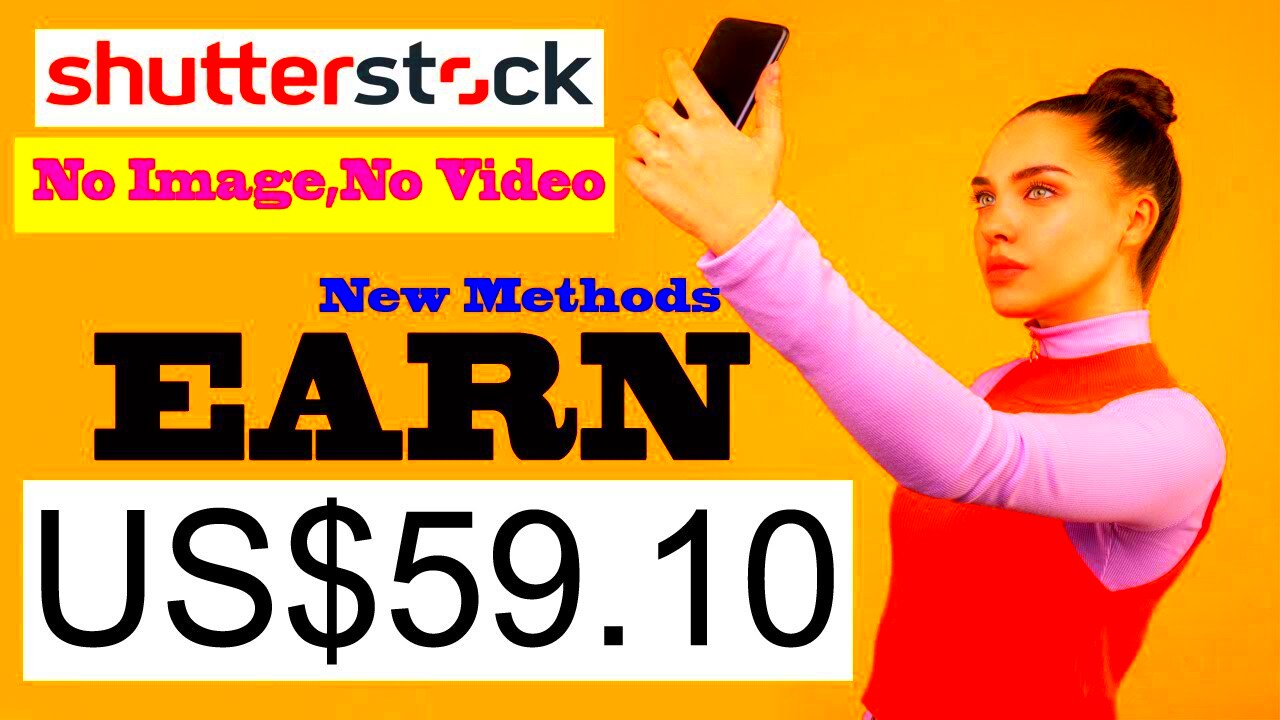Have you ever been curious about how individuals monetize their talents?
Shutterstock provides an excellent chance to transform your abilities into a revenue stream. As someone who has dabbled in the realm of stock photos and graphics I can attest to the impact
Shutterstock can have. It goes beyond simply submitting pictures; it involves grasping the platform and harnessing your imagination. In this article we will delve into ways to begin generating income through
Understanding Shutterstock and Its Platform
 Shutterstock
Shutterstock is a popular site that allows artists, illustrators and designers to showcase and sell their creations. It serves as a bridge between customers seeking top notch stock photos, graphics and footage. The way it works is simple; creators submit their material and purchasers acquire licenses to utilize these resources. Here’s a brief summary of key points to keep in mind:
- Content Categories: Shutterstock offers a variety of content types, including photos, illustrations, vectors, and videos. Knowing which category suits your skills can help you focus your efforts.
- Licensing: When buyers purchase your work, they are essentially buying a license to use it. Shutterstock provides different licensing options, so you need to be familiar with them to maximize your earnings.
- Contributor Dashboard: Once you join Shutterstock, you'll have access to a dashboard where you can track your sales, manage your portfolio, and see how your content is performing.
Grasping these fundamentals will assist you in using the platform efficiently. Its not merely a marketplace; it serves as a hub where innovation and trade converge.
How to Get Started with Shutterstock
Starting out on
Shutterstock is a pretty straightforward process but it does involve some groundwork. Here’s a breakdown of the steps I took along the way.
- Create an Account: Visit Shutterstock’s contributor page and sign up. You’ll need to provide some personal details and agree to their terms of service.
- Set Up Your Profile: Fill out your profile with relevant information. A well-crafted profile can make a difference in attracting potential buyers.
- Prepare Your Content: Make sure your images or vectors are of high quality. Follow Shutterstock’s guidelines for image dimensions, file formats, and other specifications. I remember spending hours perfecting my vectors to meet their standards.
- Upload Your Work: Once you’ve prepared your content, start uploading it to Shutterstock. You can add keywords and descriptions to make your work more discoverable.
- Review and Submit: After uploading, review your submissions and make any necessary adjustments. Shutterstock’s review team will assess your content for approval.
- Track Your Progress: Use the contributor dashboard to monitor your sales and understand which pieces are performing well. This can guide your future uploads.
Beginning this journey can feel daunting but remember to approach it gradually. With perseverance and determination you'll quickly find your balance and begin to witness progress.
Creating Quality Vector Art for Shutterstock
Making vector art that really catches the eye on
Shutterstock is a mix of creativity and skill. Based on my experience the secret lies in fusing imagination with accuracy. Here are some insights I've gained on how to create high quality vectors.
- Start with a Clear Concept: Before diving into your design software, sketch out your ideas. I often find that a rough sketch helps in visualizing the final product, making the creation process smoother.
- Use High-Quality Software: Invest in a good vector graphic software like Adobe Illustrator or CorelDRAW. These tools offer precision and control that are crucial for producing professional work.
- Maintain Simplicity and Clarity: Simple, clean designs often work best. Avoid overly complex illustrations that might not translate well at smaller sizes. I’ve noticed that minimalistic designs frequently perform better on Shutterstock.
- Pay Attention to Details: Ensure that your vectors are well-aligned, and that lines and shapes are crisp. Small imperfections can be noticeable and may affect your approval rate.
- Include Keywords and Metadata: When creating your artwork, think about relevant keywords that potential buyers might use. Properly tagging your work makes it easier for users to find.
- Follow Shutterstock’s Guidelines: Each platform has specific requirements for submissions. Make sure you’re familiar with Shutterstock’s guidelines regarding file formats, resolutions, and other specifications.
Crafting vector art requires patience and honing your skills. Don't let early setbacks or lackluster sales discourage you. With every artwork you produce you'll enhance your abilities and move closer to achieving your goals.
Uploading and Managing Your Art on Shutterstock
Submitting your art to
Shutterstock is a simple task, but how you handle it can really impact the outcome. Here’s a detailed walkthrough drawn from my personal journey.
- Prepare Your Files: Ensure that your files meet Shutterstock’s requirements in terms of format and resolution. Typically, vectors should be in AI, EPS, or SVG formats.
- Upload Your Work: Log in to your Shutterstock contributor account and navigate to the upload section. You can upload multiple files at once, which is quite handy.
- Add Metadata: Fill out the title, description, and keywords for each piece of artwork. Think about what buyers might search for and use relevant keywords. I often spend extra time on this step to ensure my work is discoverable.
- Submit for Review: Once uploaded, your work will be reviewed by Shutterstock’s team. They will check for quality and adherence to their guidelines. Be patient during this process.
- Manage Your Portfolio: Use the Shutterstock dashboard to track your uploads, monitor performance, and manage your portfolio. Regularly update your collection to keep it fresh and relevant.
By effectively handling your submissions and monitoring how they perform you can gain insights into what strategies yield the best results and use that knowledge to shape your future endeavors.
Marketing Your Vector Art to Increase Sales
Promoting your vector art is essential to increase its visibility and drive sales. Through my experiences I’ve discovered that successful marketing entails a combination of targeted promotion and actively connecting with your audience. Here are a few suggestions to kick things off:
- Optimize Your Portfolio: Make sure your Shutterstock portfolio is well-organized and showcases your best work. A clean, professional presentation can attract more buyers.
- Utilize Social Media: Share your work on social media platforms like Instagram, Pinterest, and LinkedIn. Engage with your audience by posting regularly and using relevant hashtags. I’ve seen a significant increase in traffic from my social media posts.
- Join Design Communities: Participate in online design forums and groups. Sharing your expertise and contributing to discussions can help you build a network and gain exposure.
- Collaborate with Bloggers and Influencers: Reach out to bloggers or influencers in the design space. They might be willing to feature your work, which can significantly boost your visibility.
- Offer Limited-Time Discounts: Occasionally, running promotions or offering discounts can attract buyers. Just be cautious not to undervalue your work too often.
Marketing is a continuous journey. Try out various tactics monitor how well they work and be ready to modify your methods when necessary. The key to success lies in actively connecting with potential customers and showcasing your creations. The more you put yourself out there the better your chances of achieving success.
Tips for Maximizing Your Earnings on Shutterstock
To really make the most of your income on Shutterstock it takes more than simply sharing your artwork. It’s crucial to grasp how the platform works and refine your approach. Based on my own journey these suggestions have been instrumental in increasing my sales.
- Focus on Quality Over Quantity: While it might be tempting to upload as many pieces as possible, quality is crucial. I’ve found that a few high-quality designs often perform better than numerous mediocre ones.
- Research Trends: Keep an eye on current design trends and popular themes. Incorporating trending elements into your work can increase its chances of being noticed. For instance, during the festival seasons, designs related to those themes tend to do well.
- Enhance Your Metadata: Spend time crafting effective titles, descriptions, and keywords for each upload. Think from the buyer's perspective and use keywords they might use to search for your artwork.
- Regular Updates: Continuously add new content to your portfolio. Regular updates keep your profile fresh and signal to Shutterstock that you are an active contributor. I’ve noticed a steady increase in my sales whenever I consistently add new work.
- Engage with the Community: Participate in Shutterstock forums and groups. Engaging with other contributors can provide valuable insights and networking opportunities. Sharing experiences and tips can be incredibly beneficial.
- Promote Your Work: Don’t rely solely on Shutterstock for visibility. Use social media and other platforms to drive traffic to your portfolio. I’ve had great success by sharing my work on platforms like Instagram and Pinterest.
By implementing these tactics you can greatly increase your income and maximize your Shutterstock journey. Its all about taking the initiative and constantly refining your methods.
Common Mistakes to Avoid on Shutterstock
Even experienced contributors can stumble upon pitfalls that impede their progress on Shutterstock. Looking back on my own path I’ve recognized a few common missteps to steer clear of.
- Ignoring Quality Standards: Uploading low-quality images or vectors can lead to rejection or poor sales. Always adhere to Shutterstock’s quality guidelines. I remember a few initial submissions that didn’t meet the standards and were rejected, which was a learning experience.
- Neglecting Metadata: Inadequate or irrelevant metadata can make your work hard to find. Make sure your titles, descriptions, and keywords are accurate and optimized for search. It’s a small effort that can make a big difference in visibility.
- Overlooking Trends: Failing to keep up with current trends can result in your work becoming outdated. Regularly research what’s popular in your niche and adapt your designs accordingly.
- Uploading Repetitive Content: Submitting similar or repetitive content doesn’t add value to your portfolio. Diversify your offerings to appeal to a broader audience. Unique and varied content attracts more buyers.
- Not Engaging with Feedback: Shutterstock provides feedback on your submissions. Ignoring this feedback can prevent improvement. Pay attention to the reviewer’s comments and make necessary adjustments.
- Inconsistent Uploads: A sporadic upload schedule can impact your visibility. Aim for consistency in uploading new content to maintain a dynamic presence on the platform.
By steering clear of these missteps you can make your Shutterstock experience more efficient and increase your chances of success. Take lessons from your past encounters and consistently fine tune your strategy.
Frequently Asked Questions
1. How much can I earn on Shutterstock?
Earnings on Shutterstock vary widely based on factors like the number of downloads, licensing type, and the quality of your content. Some contributors earn a modest amount, while others make a significant income. Consistency and quality play a major role in determining your earnings.
2. How often should I upload new content?
Regularly uploading new content is key to maintaining visibility and engagement. Aim to add new pieces at least once a week. This helps keep your portfolio fresh and increases the chances of your work being discovered by buyers.
3. What are the best practices for keywords and metadata?
Effective keywords and metadata should accurately describe your content and include terms buyers are likely to use. Use specific and relevant keywords to improve searchability. Avoid overloading with irrelevant terms, as this can affect the quality of your listings.
4. Can I edit my content after it’s uploaded?
Yes, you can edit the metadata for your existing content. However, if you need to make changes to the artwork itself, you will typically have to delete the existing submission and upload the revised version. Always check Shutterstock’s guidelines for any changes.
5. What should I do if my content is rejected?
If your content is rejected, review the feedback provided by Shutterstock’s review team. Use this feedback to make improvements and resubmit your work. Rejections are part of the learning process and can help you refine your submissions.
Conclusion and Final Thoughts
Starting your journey with Shutterstock can be a mix of excitement and challenges. In my view success goes beyond simply creating art; it also involves grasping the platform engaging with the community and constantly refining your methods. Keep in mind that establishing a presence on Shutterstock requires time and commitment.By prioritizing quality keeping up with trends and promoting your work effectively you can transform your creative passion into a fulfilling venture. Embrace the process of learning and continue moving ahead. With determination and a strategic mindset you'll make progress and witness the rewards of your hard work.
 Shutterstock is a popular site that allows artists, illustrators and designers to showcase and sell their creations. It serves as a bridge between customers seeking top notch stock photos, graphics and footage. The way it works is simple; creators submit their material and purchasers acquire licenses to utilize these resources. Here’s a brief summary of key points to keep in mind:
Shutterstock is a popular site that allows artists, illustrators and designers to showcase and sell their creations. It serves as a bridge between customers seeking top notch stock photos, graphics and footage. The way it works is simple; creators submit their material and purchasers acquire licenses to utilize these resources. Here’s a brief summary of key points to keep in mind:
 admin
admin








